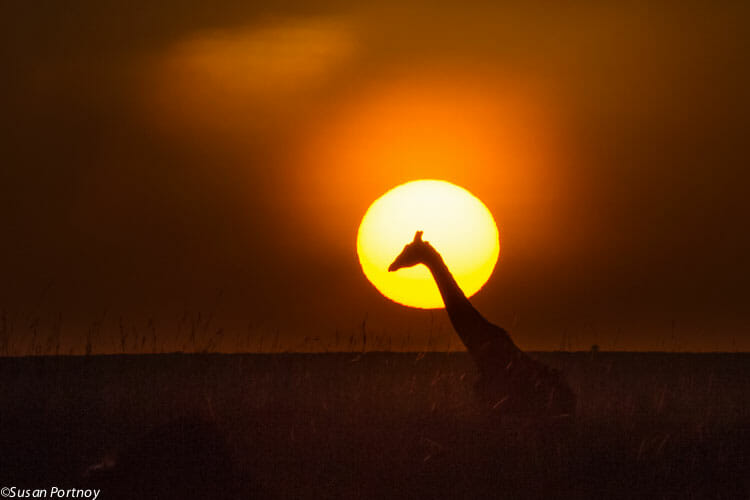
Giraffe at sunrise.
This is Susan Portnoy's second post about a photographic safari she went on in Kenya. You can read her blog, The Insatiable Traveler, or follow her on Facebook or Twitter. She also has many fabulous photos on Pinterest and Instagram. Oh, and if that doesn’t keep her busy enough, she is also a Huffington Post blogger.
As a self-professed safari addict and photography buff, I’ve always wanted to see the great wildebeest migration.
Each year, between July and October, hundreds of thousands of wildebeests move from Tanzania to Kenya, following the rains and the grass that grows in its wake. Their journey takes them across the Mara River that snakes through both countries – a dangerous path up and down steep inclines, and into waters that play host to rip currents, hungry crocodiles, and territorial hippos. Not to mention the predators who depend on this movable feast for food.
It’s considered one of Nature’s most breathtaking spectacles, and a photographer’s dream.
In September, I got my wish when I joined a 10-day photographic safari in Kenya, more specifically, the Mara Triangle, in the northwestern part of the Masai Mara National Reserve. My fellow guests and I, (8 of us in total), were in the center of all the action.
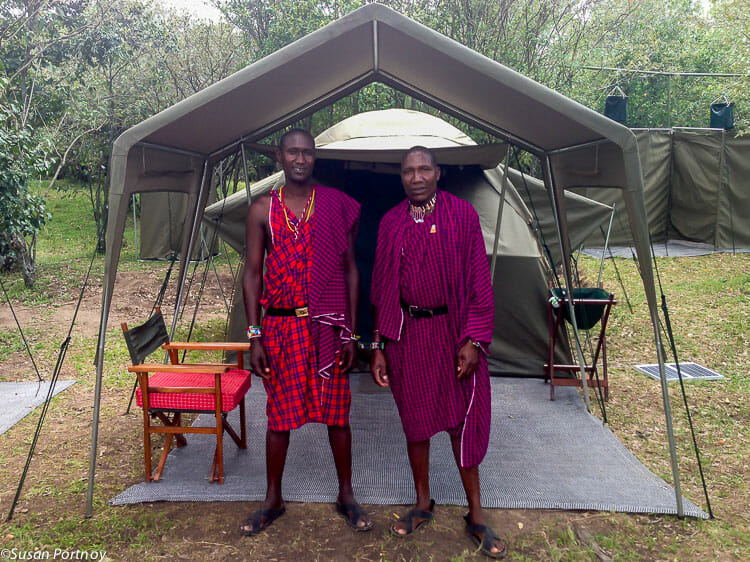
Just moments after my arrival, James and John, two of the five Maasai on the Wild Eye staff, stand in front of my home for the next 10 days.
Our hosts were the team from Wild Eye, a travel company specializing in pairing extraordinary locations with photographic instruction. (They had kindly invited me to go with them.) The camp was simple yet cozy – more rugged than glamping – and nestled on an escarpment next to the Mara River. With a pod of hippos only a couple hundred feet below us, there was no doubt we were in the bush.
Our compound included a large dining tent, a media tent (for our computers and camera equipment), and a circular fire pit to relax beside at night. The modest guest tents were furnished with comfortable wooden cots, a small table, a shelving unit, and solar powered lights. Toilets and showers were shared.
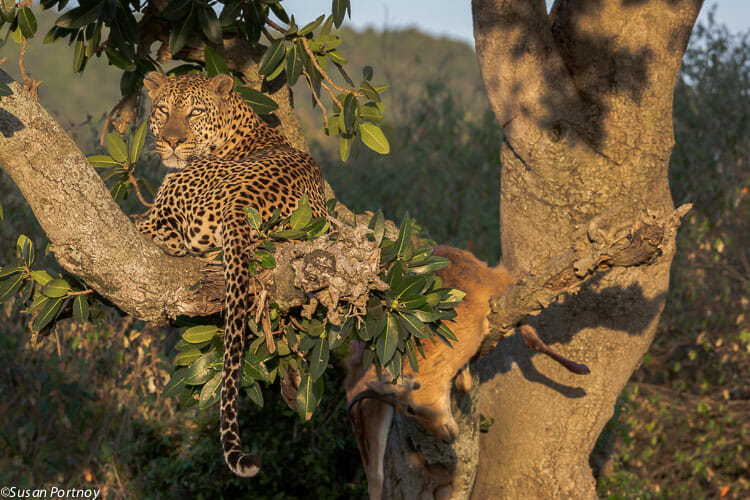
We couldn’t have asked for more: gorgeous morning light, a beautiful leopard, and his kill draped facing us on the tree next to him. Score!
While the days varied in landscape and wildlife, our schedule, for the most part, remained the same. Mornings would begin before sunrise, initiated by the members of the Maasai staff who walked from tent to tent, and with a cheerful “Jambo!” (hello in Swahili), beckoned us to wake. After a sleepy few minutes, I would throw on layers to combat the brisk morning air and head to the dining tent to meet up with the rest of the gang. By 6:30am, after a mug of hot chocolate and some biscuits, we’d pull out of camp excited to begin our day.
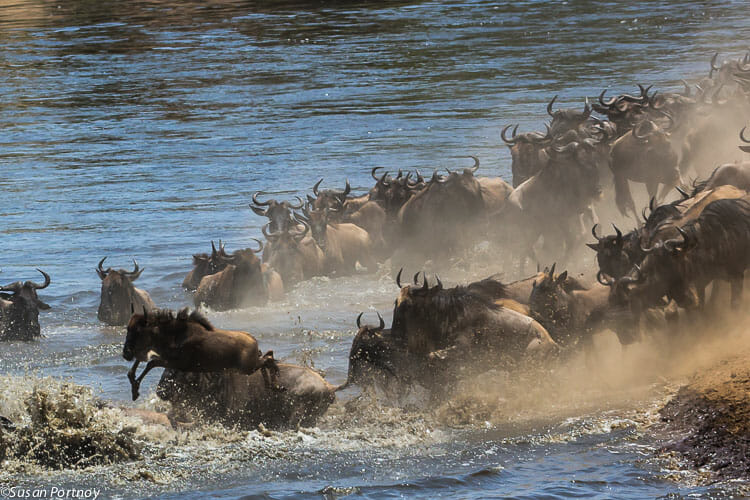
Moments after it began, I was amazed to see wildebeests leaping into the water as if their tails were on fire.
I shared a jeep with two other travelers, and our guide and driver, Jimmy. On most days, one of two Wild Eye wildlife photographers would ride with us to answer questions or recommend different ways to approach our photography. We snapped away for hours and enjoyed a steady stream of conversation and laughter.
For our group, morning drives began the same way each day, a quest to capture the quintessential iconic African image: an animal in silhouette against the sunrise. It was far easier said than done. We’d race out of camp, hoping to find an elephant or giraffe, out in the open, before the sun was too high, many times having to settle for the curve of a beautiful Acacia tree.
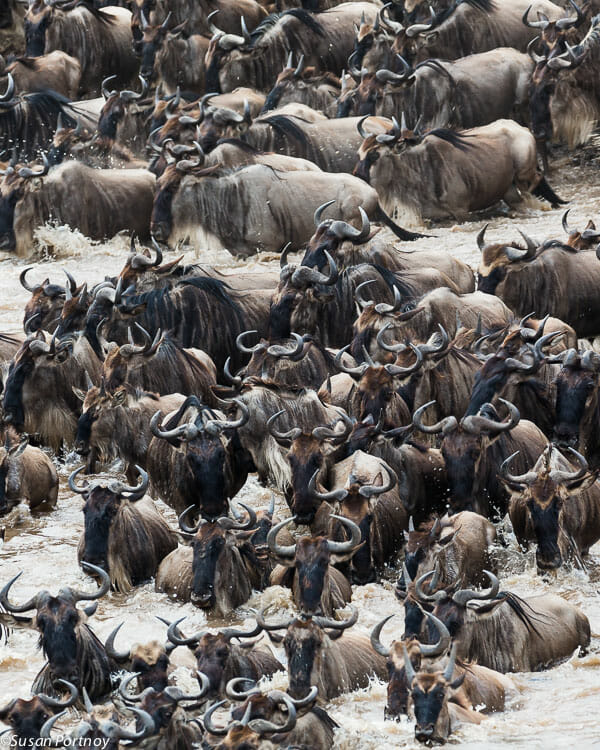
The sheer numbers of wildebeests, and the frenzy that ensues during a crossing, makes this one of the most thrilling spectacles to photograph.
Afterwards we’d check to see if wildebeests were congregating on the edge of the Mara River, a sign that they might cross. It was unclear what would motivate the herds to finally move, but at some point a wildebeest would venture down the steep rocky slope to the river’s edge, and after some hesitation, brave the water and begin to swim. Immediately the others would follow, first in single file, but quickly fanning out into a large, frenzied mass, splashing and honking, anxious to reach the other side. Individuals would jump high into the air in a spectacular show of agility before landing, often crashing into those in front of them. I didn’t see any wildebeests drown on my watch, but the threat was real, evident from the bodies peppering the shoreline.
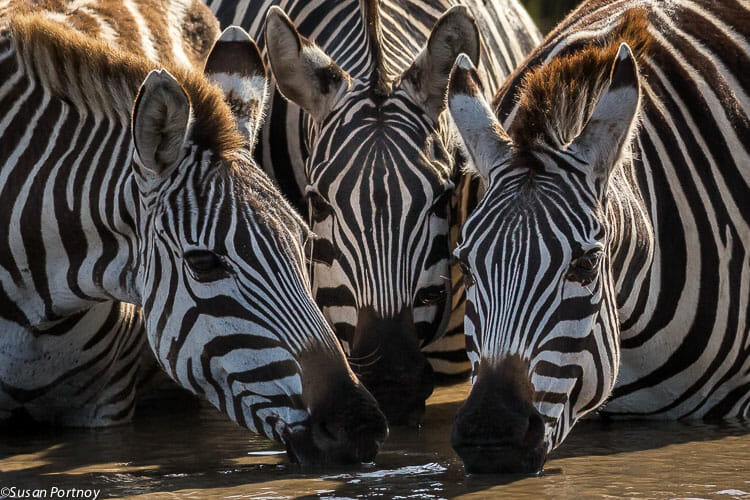
We stopped to watch a busy watering hole filled with zebra and wildebeest. A great place for images like this – all soft eyes and graphic stripes.
Once across, they’d begin to climb, occasionally choosing a path that would lead them towards our vehicles. Suddenly they would appear running full speed towards the plains behind us, wet and bedraggled.
Inside our jeep we were madly trying to keep up with the pace – long shots, wide shots, close-ups! One minute they would be in sunlight, the next in shadow. Jumping, then swimming, then running. I felt like I was shooting the Super Bowl with all its unbridled action. When it was finished, and the last wildebeest to cross was calmly grazing, I had that slight disorientation you get when you’ve been celebrating all night, and suddenly the lights come up and the party’s over.
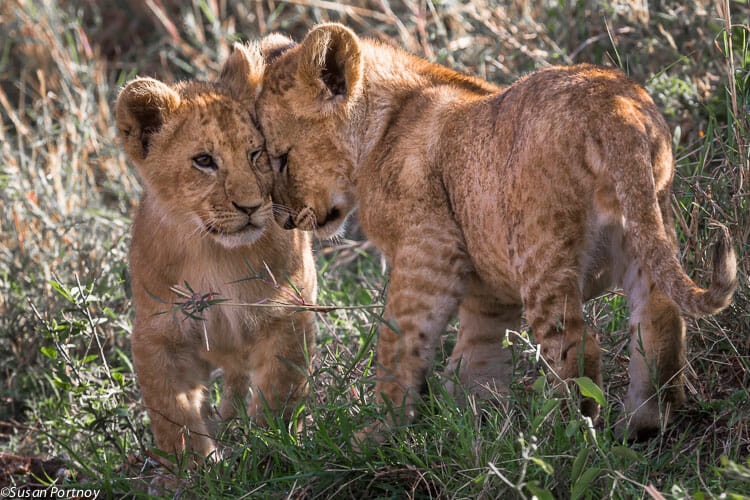
Two cubs I contemplated kidnapping. Their cuteness on a scale of 1-10 was a solid 15.
While the migration was the reason we ventured to Kenya, the wildebeests were only a fraction of the wildlife we viewed over the 10 days. We spent hours with elephants, zebras, hippos, giraffe and cheetah – the list goes on and on.
One morning, after a particularly successful giraffe sunrise, we found a large leopard in a tree, an impala next to him draped over a limb. The sunlight reflected on his coat like fire, and thankfully, he didn’t bolt when we stopped a mere 30-feet from his position. In fact, he seemed to like the attention; he’d pose this way and that; stand and then sit, and then gnaw on his impala – showing off his predator prowess for our cameras. The sighting had the perfection only found in the movies. We were beyond giddy.
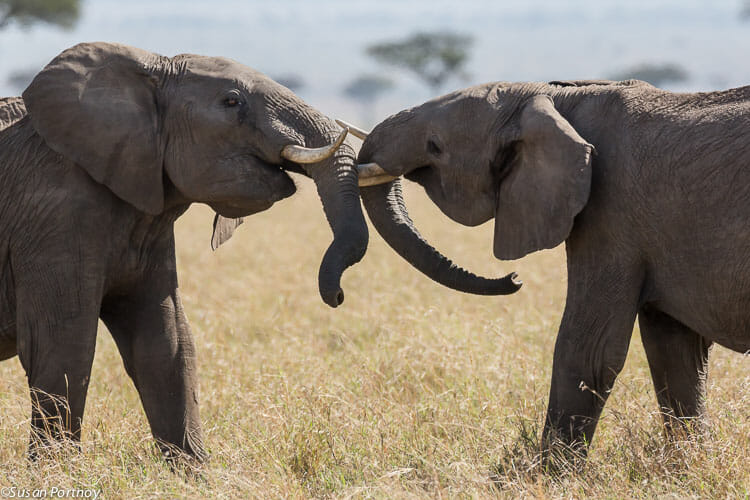
It’s hard to imagine something the size of a truck playing, but these two young bull elephant were having a grand ole time practicing their best Kung-fu moves.
We also spent a lot of time with seven, two-month old cubs. They were the offspring of two lionesses that had their little pride ensconced in a cement drainage pipe that ran under a dirt road, and so cute my heart hurt. The cubs would scamper about on paws two sizes too big for their bodies, and I seriously contemplated smuggling one home.
After a light breakfast – picnic-style out in the bush – somewhere between 12:30pm and 2pm, we’d head back to camp and start the process of downloading the morning’s images, grab a quick lunch, and by 3:30pm we were back in our jeeps
While there’s so much that captivates on the Mara, I especially loved the afternoon after a rain. The sky would turn dark blue-grey, and shafts of sunlight would break through the clouds, shining on all the animals and the vast golden grass below. The colors were so rich and opaque it was as if the horizon were color-blocked. Everything looked magical in this light and, thankfully, we were treated to it more than once.
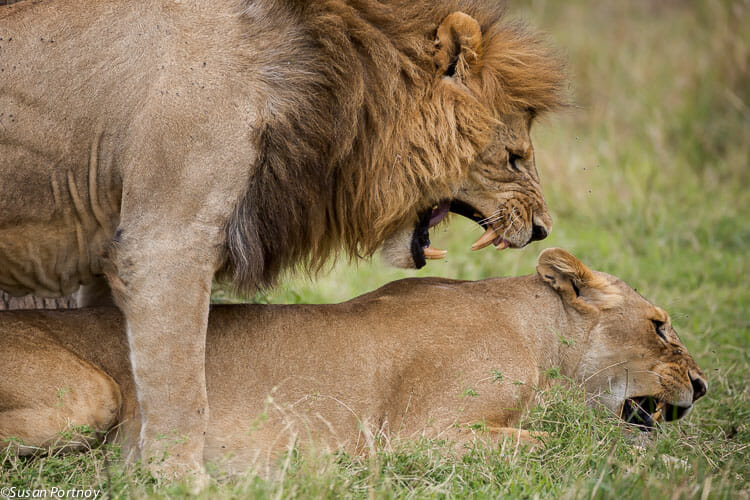
We saw a lot of this, um, “dating” in the bush. A little Fifty Shades of Grey if you ask me.
Our days in the bush would end much like they began: a quest for an animal silhouetted against the setting sun. My fondest memory is shooting a small herd of elephants against a sky so brilliantly red, I’m sure anyone who wasn’t there will assume my images are faked.
By 7pm we were back in the media tent, chatting about the day’s sightings while we processed our photos. Chilled wine in hand, we stayed this way until we were called for dinner.
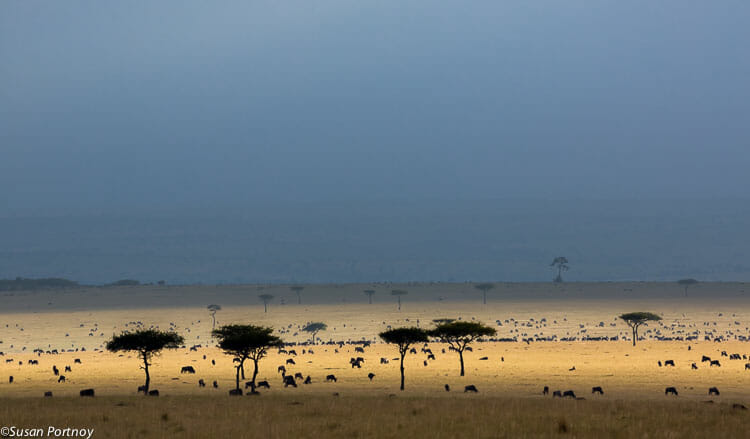
Late afternoon on the Masai Mara. Rain and sun mix to create an ethereal effect on the plains that was utterly captivating.
Exhilarated but exhausted from our adventure, most of us ended up in bed by 9:30pm. The camp would fall silent, and I would snuggle under the covers, warmed by a hot water bottle, and let the sounds of the bush lull me into a deep sleep.
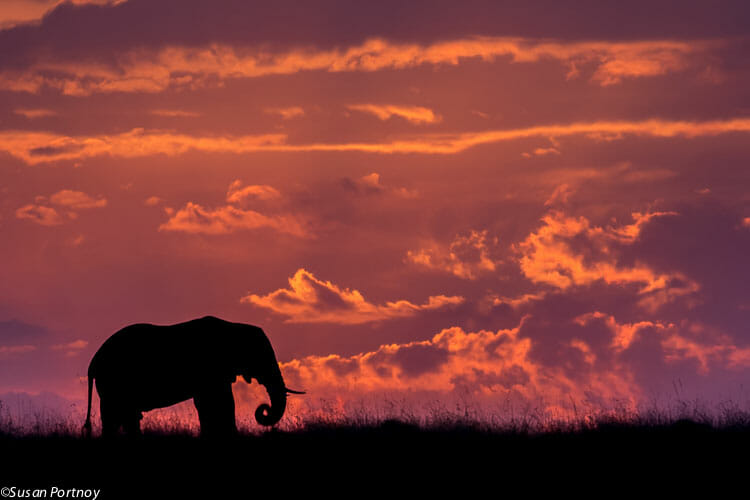
We couldn’t believe our luck – a ridiculously gorgeous sky and an elephant in silhouette. Not bad way to end the day. No siree.
